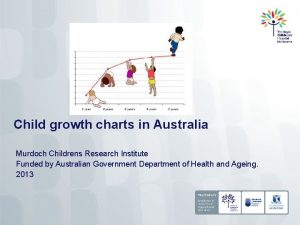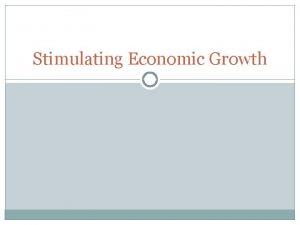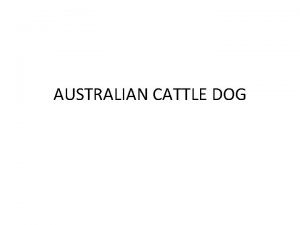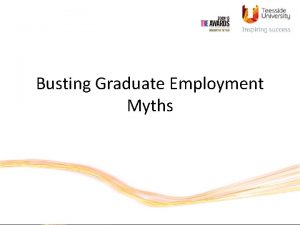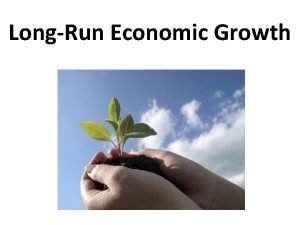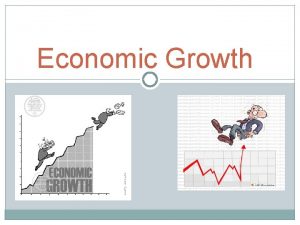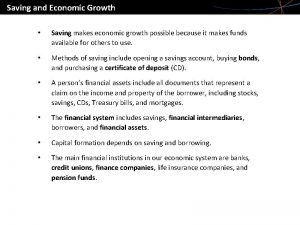Economic Growth Professor Chris Adam Australian Graduate School






















- Slides: 22

Economic Growth Professor Chris Adam Australian Graduate School of Management University of Sydney and University of New South Wales 1

INTRODUCTION • Observe rising incomes and standards of living • Know that level of GDP driven by – Capital – Labour – Technology • Changes in GDP must come from changes in factors 2

REAL GROWTH 3

GROWTH OF COUNTRIES 4

GROWTH MODEL • Solow-Swan growth model (1956) – “Dynamic capital accumulation” – Can explain how growth occurs – Can explain differences in growth – Key elements are savings and population growth – Technological progress also important but not covered here 5

GROWTH MODEL • Supply of goods and production Y = F(K, L) – Constant returns to scale – Analyze all quantities relative to labour force: Y/L = F(K/L, 1) or y = f(k) 6

GROWTH MODEL • Supply of goods and production – Slope of function is marginal productivity of capital per worker – Slope declines with increased capital per worker 7

LABOUR PRODUCTIVITY 8

GROWTH MODEL • Demand for goods and consumption – Output per worker divided between consumption goods and investment goods y=c+i – Omits government and international sectors 9

GROWTH MODEL • Demand for goods and consumption – Savings is fraction 0 < s < 1 of income, so consumption is c = (1 – s)y – Implies investment equals saving: i = sy 10

USING GROWTH MODEL • Capital stock growth and steady state – Investment (i) increases capital stock = savings (sf(k)) increases capital stock – Depreciation reduces capital stock: depreciation rate = d – Change in capital stock Dk then Dk = i – dk 11

USING GROWTH MODEL • Capital stock growth and steady state – Steady state when Dk = 0 – implying i = sf(k*) = dk* for k* steady state (constant) capital per worker 12

USING GROWTH MODEL • How savings affects growth – Increased savings rate (s) means less consumption per worker and more investment – Leads to higher level of capital stock per worker (k) – Strong empirical support 13

SAVINGS 14

USING GROWTH MODEL • What determines savings rates? • Similar investment rates do not always produce same income per worker – what else matters? 15

GOLDEN RULE OF GROWTH • Is more savings always good? – Gives larger capital stock per worker and higher output per worker – But reduces consumption per worker • Want to compare steady states to see which has highest consumption per worker 16

GOLDEN RULE OF GROWTH • Consider level of consumption at steady state c* = f(k*) – dk* Consumption is what is left of steady state output after allowing for steady state depreciation • Set level of savings to ensure c* is maximized: this is Golden Rule Savings – occurs when marginal product of k equals d 17

TRANSITION TO GOLDEN RULE • Too much capital per worker: – Policy maker lowers saving rate to Golden Rule level – Increases consumption and reduces investment – Investment rate now below depreciation rate – Reduces output, investment further – Consumption decreases from peak, but will remain above original level since at Golden Rule 18

TRANSITION TO GOLDEN RULE • Too little capital per worker: – Policy maker increases saving rate to Golden Rule level – Reduces consumption and increases investment – Investment rate now above depreciation rate – Increases output, investment further – Consumption increases from dip, and will remain above original level since at Golden Rule 19

POPULATION GROWTH • Growth in population increases workforce – Dilutes capital and output per worker at steady state – Population growth rate (n) reduces capital stock per worker in same way as depreciation Dk = i – (d + n)k = sf(k) – (d + n)k • Steady state k* from Dk = 0 = sf(k*) – (d + n)k* 20

POPULATION GROWTH • Growth in population has three effects on growth: – Better view of sustained growth drivers: total output grows – Better view of national income differences: higher population grow lowers GDP person – Golden Rule adjusted: now marginal product of capital per worker to equal (d + n) 21

TAKEAWAYS • Solow-Swan model shows – How saving sets steady state capital stock per worker and steady state income per worker – How population growth sets steady state capital stock per worker and steady state income per worker – What policy makers might do to maximize consumption per worker in steady state 22
 Economic growth vs economic development
Economic growth vs economic development Prof. meier and baldwin
Prof. meier and baldwin Who growth charts 5-19 years
Who growth charts 5-19 years Promotion from associate professor to professor
Promotion from associate professor to professor Professor chris french
Professor chris french Adam adam facebook
Adam adam facebook Defence force school of languages
Defence force school of languages Relative growth rate equation
Relative growth rate equation Monocots vs eudicots
Monocots vs eudicots Growthchain
Growthchain Primary growth and secondary growth in plants
Primary growth and secondary growth in plants Primary growth and secondary growth in plants
Primary growth and secondary growth in plants Geometric growth graph
Geometric growth graph Neoclassical growth theory vs. endogenous growth theory
Neoclassical growth theory vs. endogenous growth theory Organic vs inorganic growth
Organic vs inorganic growth Lsu thesis database
Lsu thesis database School of graduate studies upm
School of graduate studies upm Korea university portal
Korea university portal High school honor graduate requirements georgia
High school honor graduate requirements georgia Jesus seminary
Jesus seminary Uaf thesis format
Uaf thesis format Usf admission portal
Usf admission portal Graduate college
Graduate college


